- Scientific name: Carex exilis Dewey
- Species of Greatest Conservation Need (MA State Wildlife Action Plan)
- Threatened (MA Endangered Species Act)
Description
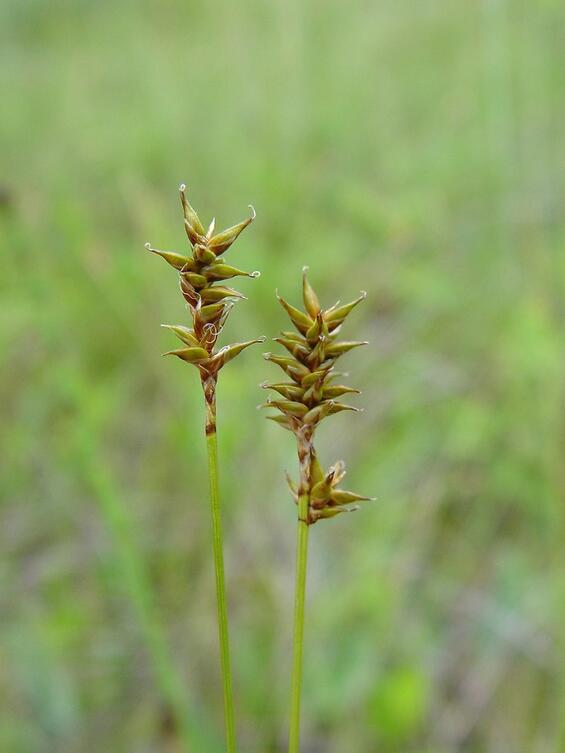
In fruit, image by Don Cameron.
Bog sedge is a perennial sedge that can grow up to 90 cm (36 in) in height and forms dense clumps. It is distinctive in that each stem usually has only a single floral spike, which usually contains staminate flowers below the pistillate flowers, though occasionally single sex spikes are observed. It has narrow leaf blades with in-rolled edges 0.4-1.5 mm (0.02-0.06 in) wide. It is an obligate wetland species.
To positively identify bog sedge and other members of the genus Carex, a technical manual should be consulted. Species in this genus have tiny, wind-pollinated flowers that are borne in spikes. Each flower is unisexual, and is closely subtended by small, flat scales that sometimes conceal the flowers. The staminate (i.e., pollen-bearing) flowers are subtended by a single scale. The pistillate (i.e., ovule-bearing) flowers are subtended by two scales, an outer flat scale (“pistillate scale”) and an inner, sac-like scale, called a “perigynium,” that encloses the flower, and later, the achene (fruit). If the perigynium tapers or contracts to a tip, it is described as a “beak.”
The stiff smooth stems with inflorescences overtop the leaves. The inflorescences are 0.6-4 cm (0.2-1.6 in) long. The subtending bract is bristle-like or absent. The perigynia are initially green and will turn to chestnut brown to dark brown as the achene ripens. They are spreading or reflexed outward and are 2.6 -4.7 mm (0.10- 0.19 in) long and 1.2-2.3 mm (0.05-0.09 in) wide, with a beak up to 1.7 mm (0.07 in) long. There are distinct veins on both surfaces of the perigynia. The achene is 1.4-2.2 mm (0.06-0.09 in) long.
Due to the solitary spike with spreading perigynia with staminate flowers below, it is unlikely to be confused with any other sedge species.
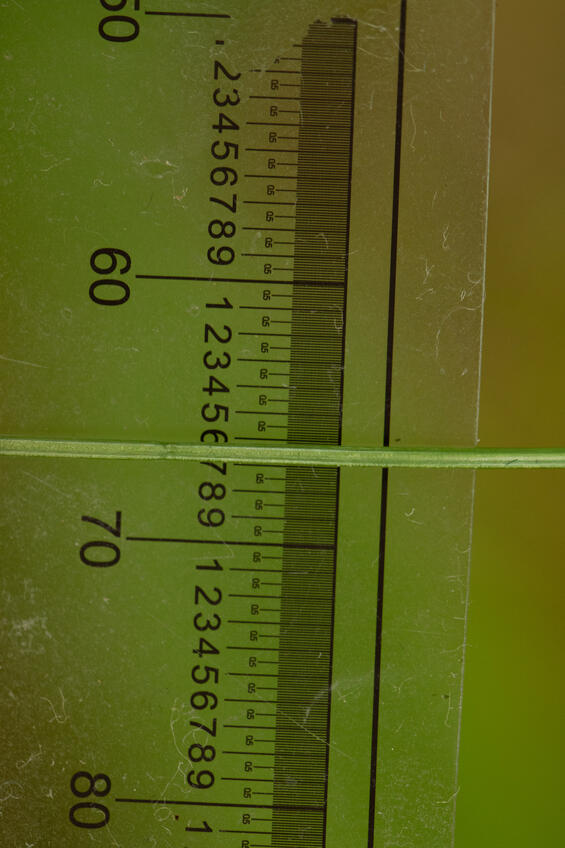
Carex exilis narrow leaf with metric ruler, image by Cole Winstanley.
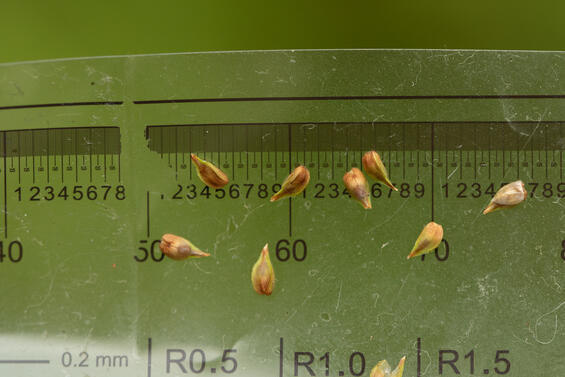
Carex exilis perigynia on ruler, image by Cole Winstanley.
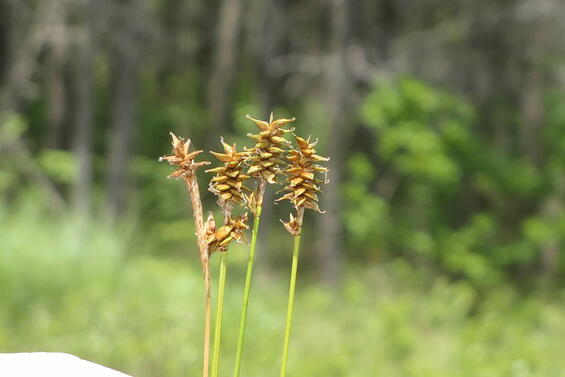
Illustrating variation of fruiting heads, image by Doug McGrady
Life cycle and behavior
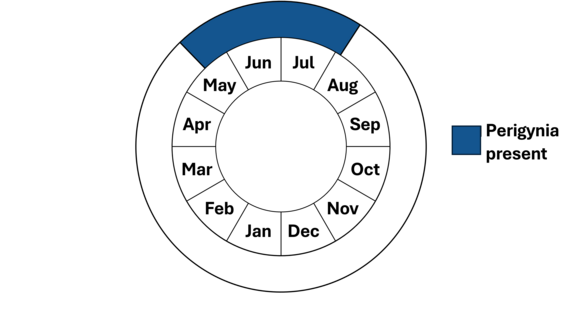
Bog sedge is a perennial sedge that is wind-pollinated. This species is an early blooming sedge and will have recognizable perigynia by mid to late May through the beginning of July. It has been reported to NHESP as late as September. The seeds are thought to fall mostly near the parent plant and be dispersed by floating on flood water through a wetland similar to other sedge species in the same habitats.
Population status
Bog sedge is listed under the Massachusetts Endangered Species Act as Threatened. All listed species are protected from killing, collecting, possessing, or sale and from activities that would destroy habitat and thus directly or indirectly cause mortality or disrupt critical behaviors. There are currently 4 occurrences in the state verified since 1999 and 33 historical occurrences, most of which were located in northeastern Massachusetts in Essex and Middlesex Counties. Single populations, now historic, have been found in Barnstable, Hampden, and Worcester Counties. Most of the older records are from herbarium collections dating to the 19th century. Typically, when a population is found, there are hundreds of stems, though some populations are smaller.
Distribution and abundance
Bog sedge is known in eastern Canada from Newfoundland to Ontario, and south into the US from Minnesota to New Jersey. There are disjunct populations in the south including in Alabama, Delaware, Georgia, Mississippi, Maryland and North Carolina. It is rare in most states where it occurs. In New England, it is considered critically imperiled in Connecticut, Massachusetts, New Hampshire, and Rhode Island and as imperiled in Vermont.
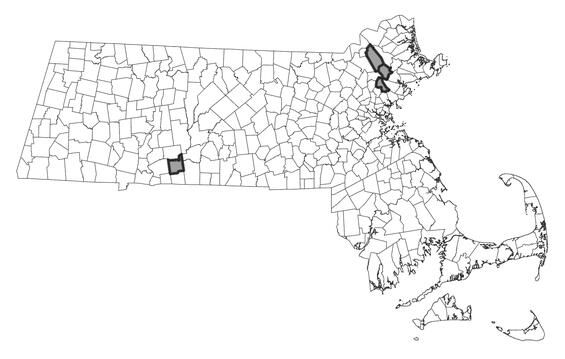
Distribution in Massachusetts
2000-2025
Based on records in the Natural Heritage Database
Habitat
This plant grows in high quality peat wetlands, bogs, fens, wet meadows, and has also been observed with Atlantic white cedar. Although a variety of habitats are possible, it is not common in Massachusetts. Associated species include Sphagnum moss, prickly bog sedge (C. atlantica), Buxbaum’s sedge (C. buxbaumii), silvery bog sedge (C. canescens), prickly sedge (C. echinata), tussock sedge (C. stricta), wooly-fruited sedge (C. lasiocarpa), panicled sedge (C. diandra), shrubby cinquefoil (Dasiphora fruticosa), spatulate-leaved sundew (Drosera intermedia), tawny cotton-grass (Eriophorum virginicum), bog aster (Oclemena nemoralis), pitcher plant (Sarracenia purpurea), marsh fern (Thelypteris palustris), and alpine clubsedge (Trichophorum alpinum). Scattered shrubs may also be found growing with bog sedge, and may include smooth alder (Alnus serrulata), Atlantic white cedar (Chamaecyparis thyoides), larch (Larix laricina), black spruce (Picea mariana), poison sumac (Rhus vernix) and cranberry (Vaccinium macrocarpon). Open wetland habitat dominated by cattails (Typha latifolia, T. angustifolia, and T. x glauca) does not contain C. exilis.
Healthy habitats are vital for supporting native wildlife and plants. Explore habitats and learn about conservation and restoration in Massachusetts.
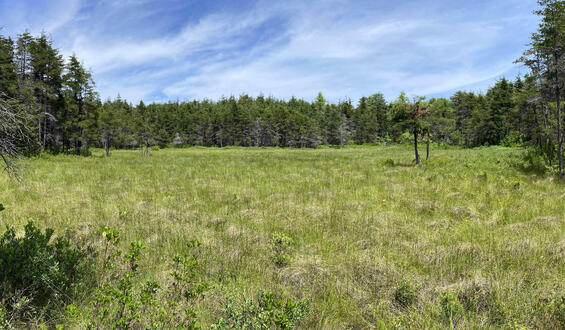
Carex exilis habitat, image by Doug McGrady.
Threats
The primary threat to bog sedge is anthropogenic changes in the hydrology of the wetland systems through water pollution and development. Beavers may also alter the hydrology of the high-quality wetlands in which this species occurs. Climate change may be a threat as it may bring not only increases in temperature not favorable for this species, but changes in the hydrology of the wetland areas through an increase in both precipitation at times and an increase and length of droughts (Staudinger et al. 2024). Invasive species, such as glossy buckthorn (Frangula alnus) and common reed (Phragmites sp.) may also threaten this species through shading. Although its reproductive capacity does not seem to be low, germination or seed predation might be limiting factors.
Conservation
Survey and monitoring
Although bog sedge is not a difficult sedge to identify when in fruit and is conspicuous, it has not been highly surveyed. Additional surveys for the species are needed as it is expected to occur in additional locations, including some that are now listed as the site of historic populations. It is best surveyed during late May into July, but the seed occasionally will remain on the plant until the end of the summer. When reporting, please report clumps of plants.
Management
The current habitat needs are not fully understood. The best management for this species is to prevent degradation of its habitats. Additional research is needed to determine further management needs.
Research needs
Bog sedge is under-surveyed, and more surveys are needed to further understand its ecological needs. Studies into the viability of its seed and dispersal need to be conducted; other sedge species growing in the same habitats are not declining. Research is needed to determine whether this plant can be grown in a nursery or garden setting for purposes of reintroductions. If habitat degradation accelerates losses of current populations, this strategy could prove useful to long-term conservation of this species.
References
Arsenault, Matt, Glen H. Mittelhauser, Don Cameron, Alison C. Dibble, Arthur Haines, Sally C. Rooney, and Jill E. Weber. 2013. Sedges of Maine, A Field Guild to Cyperaceae. University of Maine Press, Orono, Maine.
Fernald, M. L. 1950. Gray’s Manual of Botany, Eighth (Centennial) Edition—Illustrated. American Book Company, New York.
Gleason, H.A. and A. Cronquist. 1991. Manual of Vascular Plants of Northeastern United States and Adjacent Canada, Second Edition. The New York Botanical Garden, Bronx, New York.
Haines, A.. 2011. Flora Novae Angliae. The New England Wild Flower Society. Yale University Press, New Haven, CT.
Minnesota Department of Natural Resources, Rare Species Guide, Carex exilis: http://www.dnr.state.mn.us/rsg/profile.html?action=elementDetail&selectedElement=PMCYP034F0 accessed Jan. 4, 2015.
Native Plant Trust. 2014. NORM Phenology Information.
NatureServe. 2025. NatureServe Network Biodiversity Location Data accessed through NatureServe Explorer [web application]. NatureServe, Arlington, Virginia. Available https://explorer.natureserve.org/. Accessed: 3/7/2025.
POWO (2025). "Plants of the World Online. Facilitated by the Royal Botanic Gardens, Kew. Published on the Internet; https://powo.science.kew.org/ Retrieved 3/6/ 2025."
Reznicek, A.A. 2002. Carex sect. Stellulatae. Pages 326-331 in Flora of North America Editorial Committee, editors. Flora of North America, Volume 23. Oxford University Press, New York, New York.
Staudinger, M.D., A.V. Karmalkar, K. Terwilliger, K. Burgio, A. Lubeck, H. Higgins, T. Rice, T.L. Morelli, A. D'Amato. 2024. A regional synthesis of climate data to inform the 2025 State Wildlife Action Plans in the Northeast U.S. DOI Northeast Climate Adaptation Science Center Cooperator Report. 406 p. https://doi.org/10.21429/t352-9q86
Contact
| Date published: | March 26, 2025 |
|---|